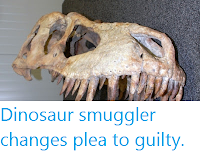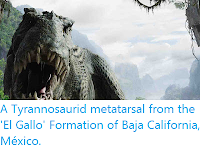Tyrannosaurs are possibly the most iconic of all Dinosaurs, appearing in almost all Dinosaur-related fiction and among the most popular exhibits in museums of palaeontology. They were large, bipedal carnivorous Therapods from the Late Cretaceous of North America and Asia, noted for their reduced forearms and (in fictional accounts) presumed ferocity. Tyrannosaur remains are quite numerous in some North American deposits, and the group has been extensively studied, though these studies have concentrated largely on the diet and locomotion of the animals, with other areas of their biology often neglected.
In a paper published in the journal Scientific Reports on 30 March 2017, Thomas Carr of Carthage College, David Varricchio of the Department of Earth Sciences at Montana State University, Jayc Sedlmayr of the Louisiana State University Health Sciences Centre, Eric Roberts of Geosciences at James Cook University and Jason Moore of Honors College at the University of New Mexico describe a new species of Tyrannosaurid Dinosaur from the Late Cretaceous Two Medicine Formation of Glacier, Lewis and Clark and Teton counties in Montana.
The new species is placed in the genus Daspletosaurus, as it is thought to be closely related to the only previously described species in this genus, Daspletosaurus torosus, and given the specific name horneri, in honour of the distinguished American palaeontologist Jack Horner, for his extensive work on the Two Medicine Formation and mentoring of many students who went on to become leaders in the field. The species is described from a complete skull, partial pectoral limb, and nearly complete hind limb, thought to come from one animal, with several other specimens referred, including an incomplete skull, partial axial series, and partial pelvic girdle and hind limb, a nearly complete dentary of a small juvenile, a maxilla, partial postorbital, and parietal, a partial mandibular ramus, a left ectopterygoid and a right ectopterygoid.
Skull and jaws of
Daspletosaurus horneri; (A) photograph and, (B) labeled line drawing of skull
and jaws in left lateral view; (C) photograph and, (D) labelled line drawing of
occiput and suspensorium in caudal view; (E) photograph and, (F) labelled line
drawing of skull in dorsal view. Scale bars equal 10 cm. Carr et al. (2017).
The largest specimen of Daspletosaurus horneri is estimated to have been 9 m in length and 2.2 m at the acetabulum (hip joint). The species has a distinctly wide dental arcade at the front of the snout compared to other Tyrannosaurids, and shows a reduction in tooth numbers in the oldest specimens, something that has been recorded in some other Tyrannosaurids, including Daspletosaurus torosus and Tyranosaurus rex (Tyrannosaurs, unlike Mammals, continuously shed and grew new teeth throughout their lives, so that the number and positioning of teeth was not fixed; this meant that as the animals grew and their jaws got longer the number of teeth tended to increase, but in some species, including Daspletosaurus horneri, the adults have a slightly reduced tooth count compared to the oldest subadults).
The growth series of
Daspletosaurus horneri, based on parsimony analysis. Unambiguously optimized
derived phylogenetic characters were recovered as synontomorphies at two of the
five growth stages, which are labeled at the corresponding numbers. Scale bar
equals 10 cm. Abbreviations: AMNH FARB, American Museum of Natural History,
Fossil Amphibians, Reptiles, and Birds; MOR, Museum of the Rockies. Carr et al.
(2017).
Several of the specimens referred to the species show exceptional preservation of the facial bones (premaxilla, maxilla, nasal, lacrimal, jugal, postorbital, squamosal, dentary), enabling Carr et al. to make an assessment of the soft tissue covering of the face. These specimens show a course, hummocky texture to the surface of these bones, similar to that seen in extant Crocodylians, which is assumed to be indicative of a scaly outer integument (skin) like that of Crocodylians.
Also preserved are the neurovascular foramina, channels in the bone through which nerves and blood vessels run. In modern Birds these are limited to the jaw tips, the caudal end of the maxilla, and in a row along the side of the lower jaw, but in Crocodylians they are arranged in repeated rows associated with the positioning of scales; this is also the pattern seen in Daspletosaurus horneri, lending further support to the idea that these animals had a face covered by a Crocodile-like scaly skin.
These neurovascular foramina are very numerous and densely packed, which is taken to be indicative of a highly sensitive snout. This is also seen in modern Crocodylians, where the facial skin plays an important role in a number of behaviours, most notably detecting movements in water that could indicate potential prey, and monitoring the temperature of nesting sites (very important for Crocodylians, which have a temperature dependent method of sex determination). Tyrannosaurids are thought to have been terrestrial hunters, making it highly unlikely that they would have used sensitive facial skin to detect movements in the water, and though Carr et al, consider it quite likely that they had a temperature dependent sex determination system and a consequent need to asses the temperature of nesting sites, they feel that this in itself would be unlikely to be the sole reason for the high levels of neurovascular development in the face of Daspletosaurus horneri. Instead they suggest that this area of skin may have been important in tactile communication, possibly with Tyrannosaurs touching or rubbing one another's faces during courtship.
See also...
Also preserved are the neurovascular foramina, channels in the bone through which nerves and blood vessels run. In modern Birds these are limited to the jaw tips, the caudal end of the maxilla, and in a row along the side of the lower jaw, but in Crocodylians they are arranged in repeated rows associated with the positioning of scales; this is also the pattern seen in Daspletosaurus horneri, lending further support to the idea that these animals had a face covered by a Crocodile-like scaly skin.
These neurovascular foramina are very numerous and densely packed, which is taken to be indicative of a highly sensitive snout. This is also seen in modern Crocodylians, where the facial skin plays an important role in a number of behaviours, most notably detecting movements in water that could indicate potential prey, and monitoring the temperature of nesting sites (very important for Crocodylians, which have a temperature dependent method of sex determination). Tyrannosaurids are thought to have been terrestrial hunters, making it highly unlikely that they would have used sensitive facial skin to detect movements in the water, and though Carr et al, consider it quite likely that they had a temperature dependent sex determination system and a consequent need to asses the temperature of nesting sites, they feel that this in itself would be unlikely to be the sole reason for the high levels of neurovascular development in the face of Daspletosaurus horneri. Instead they suggest that this area of skin may have been important in tactile communication, possibly with Tyrannosaurs touching or rubbing one another's faces during courtship.
The craniofacial epidermis of Daspletosaurus horneri, based on comparison with its closest living relatives, Crocodylians and Birds. Bone texture indicates large zones of large, flat scales and subordinate regions of armor-like skin and cornified epidermis; integumentary sense organs occur on the flat scales that cover the densest regions of neurovascular foramina. The region outside of the Crocodylian-like skin is reconstructed with small scales after fossilized skin impressions of Tyrannosaurids. Dino Pulerà in Carr et al.
(2017).
See also...
Follow Sciency Thoughts on Facebook.









